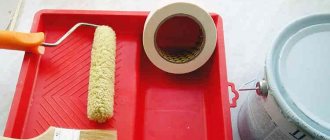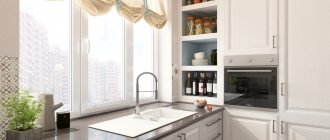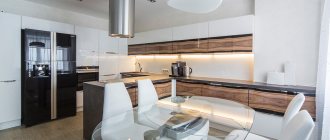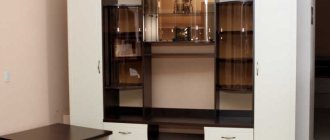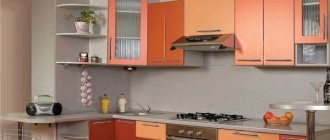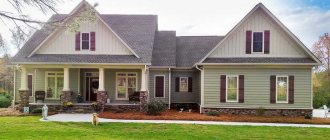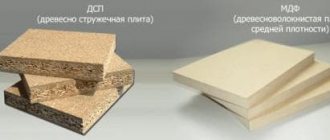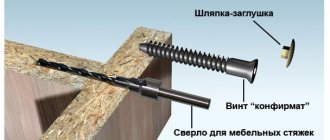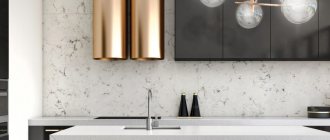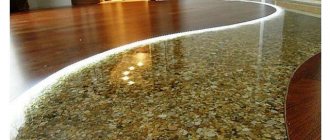There are two main requirements for the facade of any building: ensuring the protection of the structure from adverse external environmental influences and decorating the house, since it is the facade that largely determines the architectural style of the building.
Let's try to figure out which types of house faces from the currently existing options can best meet these requirements.
Facade finished with artificial stone
Manufacturing technology
MDF boards are several times more expensive than chipboard boards, which are made from chips. It is mixed with special adhesives and formed into panels under pressure. The chips have different sizes, so the structure of the slab is heterogeneous. Such panels cannot be bent, and it is also forbidden to do fine processing of the material: the edges will instantly chip. Modern technologies make it possible to cover chipboards with laminated film. It enhances the decorative properties of the material and improves its strength characteristics. Inexpensive kitchens are made from it, chipboard is often used to assemble furniture frames, and another, more expensive material, MDF boards, is used to make facades.
The manufacturing technology of MDF boards differs from the manufacturing technology of chipboards. The raw material used is not shavings, but wood chips. It is first scalded with steam, then crushed in a refiner and mixed with binding resins. The mass is sent to a dryer, where the moisture content of the workpiece is equalized, cyclones remove excess air, and forming machines compress the wood fiber mass into a carpet, which is then formed into slabs under presses. When they have cooled, they are sanded. This procedure allows you to even out the thickness of the slab and remove its external defects. Thus, the basis for further decoration is ready. MDF can be laminated, veneered, or painted with enamels. The final cost of the slabs depends on the chosen decorative layer.
A simple matte facade will cost 20% more than a facade made of chipboard. The most expensive is enamel with a shimmer effect. Furniture with such facades will cost 50% more than purchasing furniture made entirely of chipboard.
Advantages of painted facades
- Today, the production of painted facades is classified as environmentally friendly. The manufacturing process uses paints that do not contain harmful components, so the operation of the new kitchen will not cause harm to human health.
- Mixing different shades helps create the most unusual colors. The collection of factory catalogs presents a full palette of shades, but if desired, it is possible to create unusual options that bring interesting design ideas to life.
- The painted panel can easily withstand high temperatures and is not afraid of moisture. Over time, lamination and plastic begin to swell and peel off in “dangerous areas” (near the stove or sink). The paint penetrates deeply into the structure of the slab and reliably protects it from external negative factors.
- The film is easily scratched; the manufacture of painted facades involves applying a final varnish coating. It resists minor mechanical impacts, so this type of headset is difficult to damage.
- You can paint any furniture facade (straight, radius, concave).
- The method of painting MDF facades allows you to restore an old set of furniture. Modern workshops have learned to remove the film coating, prepare the base and repaint furniture, as well as give it gloss. But only if MDF boards were used for the manufacture of facades.
Read also: MDF kitchen facades
Types of structures
First, let's look at what kind of building facades there are.
They are of the following types:
- "Dry" . Such façade systems are installed without the use of adhesives or other building solutions. All elements are fastened using mechanical fasteners - nails, dowels, self-tapping screws, etc. For example, siding facades and other materials of a similar type can be called dry.
- "Wet" . An integral attribute of wet facades are various types of building mixtures. So, “wet” are called plaster facades, finished with clinker tiles (adhesive is required to attach the tiles), etc.
Scheme of a “wet” plaster with insulation
If we compare the presented types, the advantage of a “dry” facade will be the possibility of year-round installation, regardless of weather conditions. As for the “wet” system, it makes the structure more holistic.
Ventilated and non-ventilated
Regarding the question of what types of house facades there are, an additional classification should be presented.
Facade structures are divided into:
- Ventilated . This technology provides for the organization of a ventilation gap between the finishing façade material and the ceiling wall (or insulation covered with a windproof film for thermal insulation). Freely circulating air in the air gap removes moisture and dampness that occurs due to condensation on the back wall of the finishing material and penetrates from the inside to the outside through the ceiling in the form of steam. At the same time, the material itself reliably protects building floors (including insulation) from direct exposure to atmospheric phenomena.
The photo shows the facade of the house, with a ventilated system installed
- Non-ventilated . If there is no need for external insulation of the structure, and also if its walls do not “breathe,” the installation of a ventilated facade can be neglected. For example, clinker tiles can be glued to a brick wall or a concrete wall.
Advice! When finishing the facade of a wooden house, be sure to choose a ventilated system, since wood “breathes” and itself releases a large amount of moisture. If this moisture is not removed, the wooden structure of the house will begin to rot.
The instructions for arranging a ventilated facade provide for the use of not only “dry” installation methods.
So, a wooden house can be tiled in the following way:
- A sheathing is mounted on the ceiling, ensuring the presence of a ventilation gap (insulation and windproof film are laid between the lathing strips, if necessary).
- Next, the house is sheathed with OSB along the sheathing.
- Finishing tiles are glued to OSB.
Non-ventilated brick finishing
Disadvantages of painted facades
- Painted facades must not be cleaned using abrasives, hard metal brushes or brushes. If an alkaline or acidic solution accidentally gets on such a façade, it will become cloudy and covered with whitish spots.
- Under the influence of direct sunlight, any, even the highest quality enamel will fade. White facades turn yellow, and a cloudy insert appears on colored ones.
- Dyeing technology is a complex technological process. Enamels (especially those with an additional effect) are expensive, so furniture with painted facades is the most expensive type of furniture made from MDF.
Attention! Furniture with painted facades, on which additional decor is manually applied, can be compared in cost to kitchen equipment made from solid wood.
Painting and alternative processing methods
Looking at MDF-based kitchens, you can see that they come in matte, glossy, painted, laminated, milled, etc. If you are interested in MDF kitchen facades, there is a separate material where all types of decoration and coating are presented.
MDF is already a kind of classic. Furniture made from this material can be purchased to order, or you can take a ready-made version of any color, size, etc.
Painted kitchen facades, unlike other MDF-based options, can cost 20-50% more. Basically they choose what is better - painted or film. If you compare them, you can highlight a number of advantages and disadvantages.
Advantages
Reading reviews, relying on personal experience, and also talking with other craftsmen, several conclusions were made about the strengths of painted MDF.
Compared to film products, the advantages here are:
- Unique products. They are varied in color and design. Film doesn't give you that choice;
- Temperature resistance. Paint makes the coating more resistant to temperatures;
- The best protection against mechanical influences. It is extremely easy to scratch the film;
- A product of any shape and configuration can be painted;
- In this case, you can paint new panels or restore old film panels. The film is simply removed and the facade is painted;
- Painted facades must be polished. It's like with cars. The paint is polished, a protective layer is applied if necessary, and the shine is restored.
The benefits are really significant.
But it’s still worth looking at the existing shortcomings.
Flaws
Since this is enamel, which is coated with varnishes, the material has some expected disadvantages.
The weaknesses include the following:
- Weak resistance to abrasive effects, as well as to some chemicals
. Such a façade cannot be cleaned with metal brushes or scrapers. The process of destruction may also begin from exposure to alkalis, concentrated acids, solvents, etc.; - It is better to protect such a kitchen from direct sunlight
. This problem is mainly due to the coloring not being of the best quality. But still, over time, the enamel can fade; - High price
. This is a really powerful argument for many buyers; - Chips may appear
. Yes, they can potentially be repainted, but the appearance will not be the same. You will have to buy a special and quite expensive paint with a hardener.
As a last resort, kitchen facades are replaced when the situation cannot be corrected by ordinary painting.
How much the advantages outweigh the disadvantages, or vice versa, everyone decides for themselves.
Be sure to leave reviews for those who have already ordered a kitchen based on painted MDF facades. It will be interesting to know your opinion on this matter.
Reasons for the high cost of painted facades
Manufacturers use paint to create different effects on facades. The dyeing process can consist of 10 stages. The complexity and duration of the process, the need to use a large amount of consumables, as well as the use of special tools and equipment that allows you to properly dry painted facades - all this determines the pricing of the final product.
The dyeing technology is carried out as follows:
- First, the base is sanded to perfect smoothness.
- Then the first insulating layer is applied to it, helping to fill all microcracks and pores in order to level the base. After the insulation has dried, the base is sanded again.
- The next barrier layer is formed using a primer, the main purpose of which is to form a barrier that prevents the process of paint absorption deep into the slab. This procedure allows you to minimize the consumption of paint and varnish material. The primer increases adhesion, the paint will adhere better to the base, therefore, in the future it will not break off from it under the influence of certain loads.
- After the soil has dried, the first layer of paint is applied using a sprayer placed in a special chamber. Then it is left to dry completely, after which the facade is treated with sandpaper, and only after that another layer of paint is applied. The number of layers may vary. It all depends on the required paint saturation. Thus, the technology for applying paint is as follows: a layer of paint - drying - sanding - a layer of paint.
Powder coating of MDF board
Painting of MDF panels is carried out wet and dry. Wet method - applying paints and varnishes with a spray gun. After this treatment, the panel undergoes additional varnishing. Dry application method - using powder paints. The dry substance is applied to the base in an even layer, then the surface is heated to a certain temperature so that the powder begins to crystallize and melt. Having melted, the paint flows down the surface in an even layer. Finish – the process of baking the workpiece. After it, the painted surface is no different from paint applied with a spray gun.
The last stage of painting is applying a layer of varnish. To make its shine look natural, the varnished surface is dried under the influence of a certain temperature and the desired level of humidity.
Attention! Glossy facades go through one more stage: at the end they are additionally polished.
The entire dyeing process takes place under almost sterile conditions. There should be no dust in the chamber where painting is carried out. Humidity is 50%, air temperature warms up to +24 degrees (no more, no less). Each layer of paint dries on its own for exactly one day. Manufacturers have found a way to reduce drying time by increasing the temperature in the chamber to 60%. Additional effects (patination, gloss, gilding) are created entirely by hand.
Read also: Technologies for painting MDF facades
Types of coatings for kitchen facades
To give the facade an attractive look, furniture manufacturers use various coatings:
- enamel (paints, varnishes);
- plastic;
- PVC;
- veneer.
Enameled kitchen cabinet fronts
Enamel kitchen facades are products coated with special compounds: varnishes or paints.
Their advantages include:
- a wide selection of colors and effects - metallic, mother-of-pearl, gold, silver and even chameleon. Matte finishes are also available;
- enamel-coated panels are not deformable and can easily withstand moisture and high temperatures;
- Easy to clean - they can be cleaned with any non-abrasive detergents.
The disadvantage of all enamel coatings is their tendency to chip when impacted.
Plastic coating for kitchen facades
Facades covered with plastic are panels made of chipboard or MDF, to which a thin layer of plastic is attached using a special contact adhesive. This solution is rightfully considered the most practical:
- plastic does not scratch, wear off or fade over time;
- it is not afraid of the effects of chemical abrasives and is easy to care for;
- facades with such a coating do not fade for a long time.
If you want the product to last longer and not deform, give preference to models with an additional layer of compensation plastic - it prevents the facade from bending.
Kitchen facades covered with PVC film
PVC (polyvinyl chloride) is a thermoplastic material used to cover furniture facades. As a rule, PVC is used for MDF boards - it is heated and pressed tightly to the facade using special equipment. The result is a facing layer with a thickness of 0.25 to 0.5 mm.
PVC gives the product:
- resistance to mechanical stress - scratches, abrasion and shock;
- resistance to high temperatures and moisture;
- immunity to ultraviolet rays.
In addition, PVC film is much more affordable than other facing materials.
Kitchen cabinet front finished with veneer
Veneer is a layer of natural solid wood no more than 5 mm thick. The advantages of veneered facades are:
- high strength - products do not melt even when exposed to critical temperatures;
- the ability to give furniture a noble look without compromising the budget - the appearance and feel of veneered front panels are indistinguishable from expensive solid wood products;
- If the coating is damaged, you can restore the deformed area without changing the entire cladding.
The only thing in which veneer is inferior to other materials is its high price - plastic, enamel or PVC will cost less.
Materials used for painting
For painting MDF boards, three types of enamels are used:
- Acrylic enamels. They are used for the manufacture of facades of bedroom and living room sets.
- Polyurethane compounds. They are identical to the compositions used to paint cars. With their help, surfaces are created that are not afraid of moisture and sudden temperature changes. A properly processed slab becomes moisture resistant, so it is used to make furniture for the kitchen, as well as for the bathroom and plumbing unit.
- Polyester enamels are completely identical in properties to polyurethane paints and varnishes.
In the workshops there is a whole palette of shades of the material, but if the ready-made catalogs do not contain the desired color, then the craftsmen create new paints by mixing several colors.
The final price of the product is determined according to the following parameters:
- The consumption of paint material is determined by the formula 150 grams of paint per 1 sq. surface meter.
- Cost of the slab.
- Cut out and prepare the base of the future facade.
- Creation of additional effects.
Facade finishing with natural wood
Lining, wooden panels, and a block house will provide a noble look to a country property, hiding wall defects and uneven corners. A natural façade made of wooden materials will last at least 25 years with constant care. Finishing with wooden materials provides excellent ventilation of the building, and its peculiarity is the ability to create three-dimensional shapes by cutting chamfers. Finishing materials for facades made of natural wood are installed in any climate zone; they are not afraid of sudden temperature changes.
Product quality test
Only if all stages of manufacturing painted facades are followed, the result is a high-quality coating that has all the technical characteristics described just above. A low-quality coating will quickly fade and become covered with scratches, so it is important to learn to distinguish where the manufacturer has done a good job. The following tips will help you make the right choice:
- When buying ready-made furniture or ordering painting yourself, ask what materials the workshop uses. For the manufacture of kitchen facades, polyurethane or polyester enamels are used.
- In the store, take a good look at the surface of the slab from different angles. If there are unevenness, waves, or bulges on the facade, then you should not buy this furniture.
- The presence of dust particles on the top layer indicates non-compliance with the standards of manufacturing technology.
- There should be no uneven sagging or paint drips on the front side.
Clinker brick
Externally, clinker bricks are similar to ordinary building bricks. But at the same time it has a higher density and, as a result, better moisture and frost resistance. Without the need for additional waterproofing, it can last for decades without losing either its performance characteristics or its external aesthetics. So, if you want to provide reliable protection for the walls of a wooden house from rain or snow, clinker bricks will be a good choice.
In addition, it is presented in a rich range of colors - a large store can offer several hundred colors and shades. In most cases, the color is changed by adding various natural dyes to the clay, making the material not only beautiful and durable, but also environmentally friendly, which will please many potential buyers.
The surface of the brick can be any: glossy, corrugated, matte or glazed, which gives even more freedom to experienced designers.
Alas, it is often precisely because of the abundance of shades that a serious problem arises. Bricks of the same color from different batches may differ noticeably from each other. If you do not want the surface of the house to look motley after facing, you need to either buy material from one batch, or alternate bricks from different ones so that the facade looks uniform.
Now, knowing about different materials and types of cladding, you can easily decide which option will suit you in all respects - cost, service life, difficulty of maintenance. Carefully weigh all the pros and cons so that even after many decades you do not have to regret a bad choice.
Author: Mikhail Ross, civil engineer, especially for xFasad.ru
Variations in the design of painted facades
Different technologies for applying paints and varnishes make it possible to create kitchen sets of different designs.
The matte finish does not have a characteristic shine. It is widely used for the manufacture of kitchen sets in classic, minimalist and modern styles. The matte set, made in the style of retro granite, looks very unusual.
The glossy surface reflects light like a mirror, it looks elegant, bright and always festive. It is ideal for implementing the concepts of all modern stylistic trends. Glossy sets with fittings made of chrome or nickel look great.
Original special effects
- The “chameleon” effect allows you to see new colors of the facade from different lighting angles. Day and evening they constantly change their color, making the kitchen mystically mysterious. The chameleon can demonstrate its unusual beauty only on radius facades.
- The crackle effect and decoupage are often used to create classic interiors, kitchens in Provence or retro style. With its help, the surface of the furniture slightly ages and acquires a whole history of use. The crackle technique is used to imitate a web of fine wrinkles. The decoupage technique allows you to cover any thematic image with a web of wrinkles.
- The effect of pearls or mother-of-pearl is formed due to special processing, during which a coating with an optical effect is applied to the product. It creates a slight shimmer and clearly demonstrates how beautiful the play of shades can be.
- The “metallic” effect is created by mixing the coloring composition with special components that form a recognizable metallic sheen on the surface of the product. It is suitable for creating voluminous cabinets in golden or gray color.
- Stencil tint – creating an additional pattern on a painted surface. It is applied using stencils or an airbrush. Designers recommend using a similar effect only for decorating one or two facades of upper or lower cabinets.
Crackle effect
Photo printing looks elegant on painted facades. Using it, designers apply an openwork silver pattern and create a whole world using complex plots or floral prints.
Read also: Replacing kitchen facades and countertops
Reviews from owners of painted kitchens
Numerous reviews from owners of painted kitchens allow us to evaluate the balance of their advantages and disadvantages. Almost all buyers remain dissatisfied with the fact that such furniture has long migrated to the segment of expensive goods. It’s hard to argue with this, however, in fairness, it’s worth saying that only kitchens with special effects are expensive. The simpler the design, the more affordable the price of the finished product. The most expensive headsets are those that have milled handles.
Another negative point is the appearance of cracks and chips in a visible place after many years of use. They are explained by the fact that the furniture has already developed its potential. The paint is applied in layers, furniture is painted using the same technology as a car. The difference is that MDF dries out over time, so the paint layer becomes deformed. Restorers recommend covering up such defects with regular nail polish. If you can match the color, the damage will be less noticeable.
You cannot re-order facades after installing the main set. This is another observation that is discussed in detail on the forums. No experienced craftsman can get into the color of the paint (especially when the customer chooses complex paints obtained by mixing different shades). It is impossible to choose a color with a special effect one hundred percent. If such a situation arises, there is only one way out - completely change the doors of the set, repaint them again.
